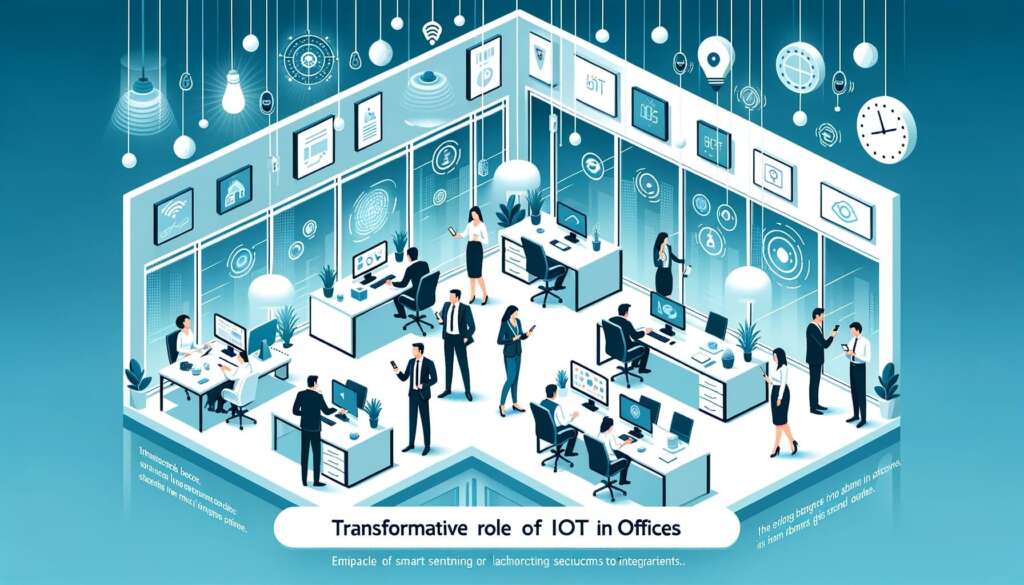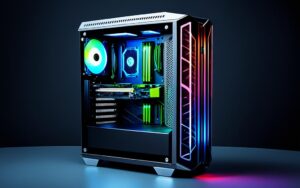Table of Contents
In today’s fast-paced business world, Exploring the Internet of Things (IoT) in Office Environments is not just a trend but a necessity for staying competitive. The integration of IoT technologies into the workplace is transforming traditional office setups into intelligent ecosystems. These smart environments are capable of self-regulation, automation, and offer an enhanced user experience. Whether it’s smart lighting systems that adjust according to natural light or automated HVAC controls that optimize temperature for employee comfort, IoT is making a significant impact.
The benefits are manifold; from streamlining business operations to significant cost reduction, the advantages of a connected workspace are hard to ignore. As companies increasingly look to modernize their operations, understanding the role and applications of IoT becomes crucial. This comprehensive guide aims to cover the various facets of IoT in office settings, from its applications to its challenges, and how businesses can successfully make the transition to a smart office.
Internet of Things: What is IoT?
The term Internet of Things (IoT) refers to the network of interconnected devices that communicate with each other through the internet. These devices range from simple sensors and actuators to complex machinery like HVAC systems and security cameras. In an office environment, IoT technologies can include everything from smart lighting and climate control to advanced security systems and automated coffee makers.
Types of IoT Devices Used in Offices
The Internet of Things (IoT) has ushered in a new era of connectivity and automation in office settings. Here are some common types of IoT devices that are transforming the way we work:
Smart Thermostats
These devices allow for precise control over the office’s heating and cooling systems. They can be programmed to adjust the temperature based on occupancy or time of day, leading to energy efficiency.
Voice-Activated Assistants
Devices like Amazon’s Alexa or Google Assistant are being integrated into office environments to assist with tasks such as scheduling, reminders, and even controlling other IoT devices.
Connected Printers
Gone are the days of traditional printers that only connect via a local network. IoT-enabled printers can be accessed remotely, allowing for more flexible printing solutions and easier maintenance.
Smart Locks and Access Control
Security is a major concern for any office, and IoT smart locks offer a higher level of control. These devices can be controlled remotely and can even provide logs of who has accessed certain areas.
Indoor Positioning Systems
These are used to track assets or people within a building. They can be particularly useful in large office spaces where finding a meeting room or a particular desk can be challenging.
Wearable Devices
From smartwatches to fitness trackers, wearables are being used to promote employee well-being by tracking health metrics and encouraging regular movement.
Automated Cleaning Equipment
Robotic vacuum cleaners and other automated cleaning devices can be scheduled to clean the office during off-hours, ensuring a clean workspace without disrupting the workday.
Applications of IoT in Office Environments
The Internet of Things (IoT) has a wide range of applications that can significantly improve the efficiency and functionality of an office environment. Below are some key areas where IoT can make a substantial impact:
Smart Lighting Systems
IoT-enabled smart lighting systems can automatically adjust the lighting levels based on the time of day or occupancy. This not only enhances the work environment but also contributes to energy savings and cost reduction.
Automated HVAC Controls
With smart HVAC systems, offices can achieve a new level of comfort and energy efficiency. These systems can be programmed to adjust the temperature and air quality based on real-time data, such as occupancy levels and external weather conditions.
Security Systems
IoT-enhanced security systems offer a robust solution for office security. From smart locks to surveillance cameras and even biometric systems, these IoT devices can be controlled remotely, offering both convenience and peace of mind.
Office Automation Tools
IoT devices extend their utility to mundane tasks as well. From smart coffee makers to automated cleaning robots, these devices can handle a variety of tasks, thereby freeing up human resources for more critical functions.
Benefits of Implementing IoT
The advantages of incorporating IoT into an office environment are manifold. One of the most immediate benefits is cost reduction. Smart lighting systems and automated HVAC controls can significantly lower energy bills by ensuring that resources are used only when necessary. For example, smart thermostats can adjust the temperature based on occupancy, thereby reducing energy consumption.
Another significant advantage is the improved user experience for employees. IoT devices can automate mundane tasks, allowing staff to focus on more critical aspects of their work. Smart coffee makers can prepare your morning brew before you even arrive, and intelligent scheduling systems can optimize meeting room bookings, enhancing overall productivity and employee satisfaction.
Lastly, IoT contributes to streamlined operations. Real-time data from various sensors can provide valuable insights into how different areas of an office are utilized. This data can be used to optimize space, reduce waste, and improve operational efficiencies. For instance, smart security systems can provide real-time alerts, allowing for quicker response times in case of emergencies.
Internet of Things: Challenges and Risks
The journey to a fully integrated IoT office environment is not without its challenges and risks. Here are some of the critical issues that businesses need to consider:
Data Security
The interconnected nature of IoT devices makes them susceptible to cyber threats. Ensuring data security is paramount, as a single breach can compromise the entire network, putting sensitive business data at risk. Robust encryption methods and regular software updates are essential to safeguard against these vulnerabilities.
Ethical Considerations
The use of IoT devices in an office setting raises ethical questions, particularly concerning employee privacy. Surveillance cameras and tracking devices, for instance, must be used responsibly to avoid infringing on individual privacy rights. Clear guidelines and policies need to be in place to navigate these ethical waters.
Initial Setup Costs
While IoT promises long-term cost savings, the initial setup can be expensive. This includes the purchase of IoT devices, the cost of software solutions, and potential infrastructure upgrades. Businesses must weigh these initial costs against the long-term benefits to determine the viability of IoT implementation in their office environments.
Internet of Things: Case Studies
The practical application of IoT in office environments can best be understood through real-world case studies. These examples offer valuable insights into the benefits, challenges, and best practices associated with IoT implementation.
Examples of Offices Successfully Utilizing IoT
- WeWork: This co-working giant has implemented IoT sensors to monitor room occupancy and adjust lighting and temperature accordingly. This not only enhances the user experience but also contributes to significant energy savings.
- Cisco: Known for its networking solutions, Cisco has integrated IoT into its own offices. Smart badges track employee movements to optimize space utilization, while IoT-enabled video conferencing improves meeting efficiency.
- Johnson Controls: Specializing in building efficiency solutions, Johnson Controls uses IoT to manage its complex HVAC systems, thereby reducing energy consumption and operational costs.
Lessons Learned
From these case studies, it’s clear that while IoT offers numerous benefits, its implementation must be carefully planned to mitigate risks like data security and ethical concerns. Companies that have successfully integrated IoT have done so with a comprehensive strategy that addresses these challenges head-on.
Future Trends
As we look ahead, the role of IoT in office environments is set to evolve further, driven by advancements in technology and a growing focus on sustainability and efficiency. Here are some future trends that are likely to shape the IoT landscape in offices:
AI and Machine Learning Integration
Artificial Intelligence (AI) and machine learning algorithms are increasingly being integrated with IoT devices. This allows for more intelligent decision-making, such as predictive maintenance for HVAC systems or advanced security protocols that adapt in real-time to emerging threats.
Increased Automation and Connectivity
The future will see a more interconnected office environment, where IoT devices communicate seamlessly with each other. This will lead to increased automation, from smart lighting systems that adjust according to natural light levels, to advanced office tools that automate routine tasks, freeing up human resources for more complex work.
By staying ahead of these trends, businesses can better prepare for the future, optimizing their operations and creating a more comfortable, efficient, and secure office environment.
Internet of Things: Conclusion
In summary, the Internet of Things (IoT) has significantly transformed the way offices function, offering a plethora of benefits from cost reduction to enhanced security. As we move towards a more connected future, the role of IoT in office environments will only continue to grow. However, it’s crucial to address the challenges and risks associated with IoT implementation, particularly in the areas of data security and ethical considerations. By taking a balanced approach and learning from successful case studies, businesses can fully harness the power of IoT to create more efficient, productive, and sustainable office environments.









